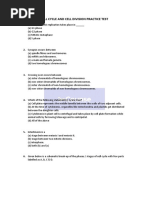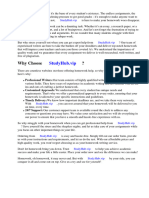Cell Cycle and Cell Division DPP-1
Uploaded by
swapnilgange123Cell Cycle and Cell Division DPP-1
Uploaded by
swapnilgange123QUESTION BOOKLET VERSION : 11
Sub. Biology Cell Cycle & Cell Division DPP-1
1 . The diplotene subphase of prophase-I can last 4.
Column-I Column-II
for months or years in :
a Nuclear 1 Heart cell
RCC** RCC** RCC** RCC** RCC** RCC** RCC** RCC** RCC** RCC** RCC** RCC** RCC** RCC** RCC** RCC** RCC** RCC** RCC** RCC** RCC**
1) Oocytes of all vertebrates
division
2) Spermatocytes of all vertebrates
b Cytoplasmic 2 Liquid
3) Megaspore mother cells
division endosperm
4) Oocytes of some vertebrates
c Quiescent 3 Cytokinesis
2. Given below is the representation of a certain
event at a particular stage of a type of cell stage
division. Which is this stage? d Syncytium 4 Karyokinesis
1) a-3, b-4, c-2, d-1 2) a-3, b-4, c-2, d-1
3) a-4, b-3, c-1, d-2 4) a-4, b-3, c-2, d-1
5. Read the following statements :
i) Prophase is marked by the initiation of
condensation of chromatin material
1) Prophase I during meiosis
ii) The chromosomal material becomes
2) Prophase II during meiosis untangled during the process of chromatin
3) Prophase of mitosis condensation
4) Both prophase and metaphase of mitosis iii) In the S and G 2 phases the new DNA
3. Select the correct option: molecules formed are not distinct but
interwound
Column-I Column-II
iv)Nuclear envelope remains intact
A Synapsis aligns homologous i) Anaphase II
throughout the prophase
chromosomes
B Synthesis of RNA and protein ii) Zygotene
v) At the end of prophase, when viewed under
microscope, a cell shows distinct Golgi, ER
C Action of enzyme recombinase iii) G2-phase
and nucleolus
D Centromeres do not separate iv) Anaphase-I How many of the above statements are correct
but chromatids move towards ?
opposite poles
1) Three 2) Four
v) Pachytene
3) Two 4) One
1) A = (ii) B = (iii) C = (iv) D = (v)
2) A = (ii) B = (i) C = (iii) D = (iv)
3) A = (ii) B = (iii) C = (v) D = (iv)
4) A = (i) B = (ii) C = (v) D = (iv)
17
You might also like
- Coding Club Level 3 Python Building Big Apps PDF100% (1)Coding Club Level 3 Python Building Big Apps PDF134 pages
- Approaches To Understanding and Measuring Interdisciplinary Scientific Research (IDR) : A Review of The LiteratureNo ratings yetApproaches To Understanding and Measuring Interdisciplinary Scientific Research (IDR) : A Review of The Literature13 pages
- Cell Cycle and Cell Division - Revision_QuestionsNo ratings yetCell Cycle and Cell Division - Revision_Questions88 pages
- Chapter-10: Cell Cycle and Cell DivisionNo ratings yetChapter-10: Cell Cycle and Cell Division13 pages
- Cell Cycle and Cell Division Practice Test100% (1)Cell Cycle and Cell Division Practice Test12 pages
- NEET Cell Cycle and Cell Divisions Important Questions With Answer Key Free PDFNo ratings yetNEET Cell Cycle and Cell Divisions Important Questions With Answer Key Free PDF13 pages
- NEET (Cell Cycle And Cell Division) 08-02-2025 [LT26 SP (NK)]No ratings yetNEET (Cell Cycle And Cell Division) 08-02-2025 [LT26 SP (NK)]8 pages
- Cell Cycle & Cell Division : Speed Practice Sheet || Arjuna NEET 2.0 2024No ratings yetCell Cycle & Cell Division : Speed Practice Sheet || Arjuna NEET 2.0 20244 pages
- 10 Cell Cycle N Cell Division-Entrance Questions With AnswersNo ratings yet10 Cell Cycle N Cell Division-Entrance Questions With Answers3 pages
- 2366364-CLASS 11 - BIOLOGY - CELL CYCLE AND CELL DIVISION - WS WITH ANS - AGNESNo ratings yet2366364-CLASS 11 - BIOLOGY - CELL CYCLE AND CELL DIVISION - WS WITH ANS - AGNES7 pages
- Cell Cycle & Cell Division - NCERT Based PYQsNo ratings yetCell Cycle & Cell Division - NCERT Based PYQs6 pages
- Cell Cycle and Cell Division Practice PaperNo ratings yetCell Cycle and Cell Division Practice Paper5 pages
- Cell Cycle and Cell Division 2023 24 12 02 58 50No ratings yetCell Cycle and Cell Division 2023 24 12 02 58 5071 pages
- Inter-material-Istyearem-botany-unit v Cell Cycle and Cell Division 11No ratings yetInter-material-Istyearem-botany-unit v Cell Cycle and Cell Division 118 pages
- PPT_Unsolved_Revision_With_Rupesh_Sir_Botany_Arjuna_NEET_2025_RupeshNo ratings yetPPT_Unsolved_Revision_With_Rupesh_Sir_Botany_Arjuna_NEET_2025_Rupesh40 pages
- 8. Cell Cycle and Cell Division - Botany - NEET Work SheetNo ratings yet8. Cell Cycle and Cell Division - Botany - NEET Work Sheet12 pages
- Cell Cycle and Cell Division High Yield MCQs For NEET 2022 RevisionNo ratings yetCell Cycle and Cell Division High Yield MCQs For NEET 2022 Revision5 pages
- Statement Wise Objective Practice Questions Cell Cycle and CellNo ratings yetStatement Wise Objective Practice Questions Cell Cycle and Cell5 pages
- Annual Plant Reviews, Polarity in PlantsFrom EverandAnnual Plant Reviews, Polarity in PlantsKeith LindseyNo ratings yet
- Group-Contribution Estimation of Activity Coefficients in Nonideal Liquid Mixtures. Aiche 1975No ratings yetGroup-Contribution Estimation of Activity Coefficients in Nonideal Liquid Mixtures. Aiche 197514 pages
- Performance Review Toolkit - Tools, Tips, Templates, and MoreNo ratings yetPerformance Review Toolkit - Tools, Tips, Templates, and More41 pages
- Chapter Three Chapter Three The Multiple Linear Regression (MLR)No ratings yetChapter Three Chapter Three The Multiple Linear Regression (MLR)50 pages
- CV For Road Safety Specialist - PDF - CompressedNo ratings yetCV For Road Safety Specialist - PDF - Compressed8 pages
- Railway Signalling Technology-System Design OverviewNo ratings yetRailway Signalling Technology-System Design Overview9 pages
- The Five Generic Competitive StrategiesNo ratings yetThe Five Generic Competitive Strategies39 pages
- The Present Perfect Tense and Past PerfectNo ratings yetThe Present Perfect Tense and Past Perfect5 pages
- MODELS 373LAV, 376CAV Downflow/Horizontal and 383kav, 395cav Upflow Gas Furnace50% (2)MODELS 373LAV, 376CAV Downflow/Horizontal and 383kav, 395cav Upflow Gas Furnace12 pages
- Siemens Simatic S7-1200 - PLC-City - PLC-CityNo ratings yetSiemens Simatic S7-1200 - PLC-City - PLC-City12 pages
- Ac090fcapeh PCC Compartment Samsung Outdoor UnitsNo ratings yetAc090fcapeh PCC Compartment Samsung Outdoor Units66 pages
- Political Engagement External Statement July 2020No ratings yetPolitical Engagement External Statement July 20202 pages
- Performance Assessment and Review Admin and Accounts ManagersNo ratings yetPerformance Assessment and Review Admin and Accounts Managers3 pages
- 11-09-2022 - SR - Super60 - Jee-Adv (2020-P2) - RPTA-01 - Key & Sol'sNo ratings yet11-09-2022 - SR - Super60 - Jee-Adv (2020-P2) - RPTA-01 - Key & Sol's10 pages
- Configuring Sequences With SFC: Simatic Pcs 7No ratings yetConfiguring Sequences With SFC: Simatic Pcs 720 pages

























































































